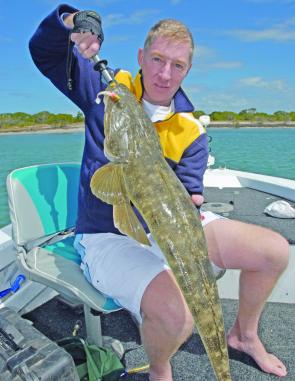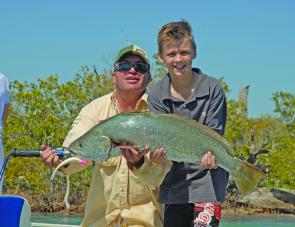The water and the action improves this month and with hot days and late afternoon storms it is time to start thinking about chasing a few mangrove jacks. In general the run out fishes better than the run in, and jacks live tight in on rocky snags rather than mangroves as their name suggests. The key to jack fishing is finding good back eddies in fairly strong current. Look around bridges, canal corners and rocky points. Mullet, herrings and disturbed water are all good clues as to where the fish will be.
In November the Nerang and south arm of the Coomera River offer the most opportunities. A low tide around 9pm is a good night to fish. Lure options include soft plastics, deep trolled minnows like the Storm Thunderstick, poppers and fizzers. At times shallow running minnows work well when fish are hitting the top chasing bait.
As well as Jacks, lure fishermen should expect to catch a few estuary cod, GTs, big eye trevally and flathead. By the moon in November most of the flathead have spawned and are moving back into the main body of the estuary. On the cooler days there should still be plenty of solid lizards at the seaway entrance and Jumpinpin, but they tend to fade out later in the month as the adult fish move back up the estuary. Flathead don’t seem to like a water temperature above about 23°C, and if hot northerly winds blow the fishing will be tough. This wind sends the water a brownie colour and there is a lot of floating weed.
The upper reaches of the Nerang and Coomera should fish well this month if the dry conditions remain. There are quite a few rocky corners in these upper areas that can produce excellent lure casting at times for bream, trevally jacks and flathead. As the water warms shrimp become very plentiful and small surface lures such as the Smith’s Towadi are a great way to fish for bream and even whiting when the shrimp are skipping across the top.
Whiting should be biting well this month, especially in the Nerang River between the Southport school and Sorrento. Bloodworms, soldier crabs, shrimp and wrigglers are the best bait. The river is in desperate need of rain at the moment, and evening storms should improve the fishing this month. A run in tide early in the morning is the best conditions for whiting. Fish light line and a long leader. In recent seasons we have used shrimp almost exclusively for whiting. These are easily caught with a dip net around mangroves and sandy edges and have the added advantage that they can be caught on a full tide. Fished on a small number 6 Aberdeen hook using three at a time seems to be the best method. They have worked as effectively as wriggler worms for us and also catch plenty of bream, grunter and flathead.
Overall it is a good month on Gold Coast estuaries. Get up early before the wind, heat and crowds and you may be pleasantly surprised at how good the fishing can be in our local rivers.
Last November saw the first run of pelagics hit our shores, with both dolphin fish and small Wahoo turning up on a pretty regular basis. This month used to be considered too early in the season to seriously chase black marlin, but we did catch a couple in November 2006. From reports coming from more northern ports the marlin fishing has been pretty thin pickings this season, and small black marlin in particular have been scarce. This doesn’t augur well for the season ahead, but we have in the past had good fishing on medium black marlin from 50 to 100kgs in seasons where the little marlin don’t show.
Dolphin fish however, are generally a good target in November. Wahoo have definitely increased in number over the past few seasons with large numbers of juvenile fish turning up early in the season. This can be a very expensive business when they chew into your favourite marlin lures.
Out wider this month there is the possibility of striped marlin and yellowfin. The water temperature in November is generally around 23°C, although later in the month the first push of the summer currents begins and the temperature increases a bit. The full effect of this east Australian current generally begins in December.
Snapper should still be around on the 36 and 50 fathom line with a few pearl perch. Kingies and amberjacks will also still be present and can be caught on live baits and jigs. On the close reefs of Palm Beach November often sees a good run of cobia on the full moon towards the end of the month. Occasionally a few spotted mackerel also turn up early in November. A good way to fish is to berley and live bait over the top of the reef complex. Some of the November cobia are over 30kgs.
The area just in front of the Seaway is also worth a look this month on the run out tide. There is often a good colour change present on the northern side of the tide line, and this area can provide some very exciting fishing for Mac tuna, tailer, bonito, trevally and mulloway. There are a lot of bait schools on offer up on the sandy drop off and there are also generally plenty of sharks as well. This is a very productive area to fish but keep well away from the breaking sandbank to the north of the entrance.
On another note, the Hinze Dam has really fished very well over the past few months, with fish over 50cm now being relatively common. As the water warms up these fish will begin feeding actively on the surface and also react to spinner baits. Lately the bass fishing is the best on the Hinze that I’ve ever experienced, and it is a beautiful dam to fish.
Reads: 3709
Mitch Calcutt with an 87cm flathead from Junpinpin.

A nice Jewie on a jerk shad from near Kalinga Bank.

A wahoo - get ready for more.




